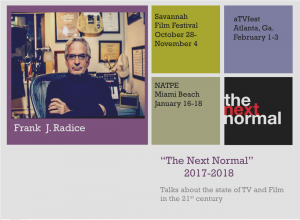
In “the next normal,” what we now know as television will be dead, and marketing the next iteration of TV will not be dependent on brand.
These are two bold yet not mutually exclusive statements.
People don’t watch brands…they watch video.
Spending to market NBC, ABC, CBS, Fox, all the cable channels in the niche categories, and the hot OTT’s of the day, Netflix, Hulu, Amazon, Facebook Live Streaming, Snap and Instagram Stories, just won’t matter as stand alone providers.
The user experience will define the medium as much as the content defines a brand now, and the advertising around and in the content will play as much of a role as traditional branding does now.
Internet video will account for 80 per cent of total consumer Internet traffic by 2019, compared to 64 per cent currently, according to a report on audio-visual services in the digital era by a Rome-based think-tank. In fact, the younger generation, children between the ages of 5 and 15, now spend more time on the internet than they do watching TV on a regular TV set, according to UK telecoms regulator Ofcom. The latest connected entertainment research findings from market research and consulting company Parks Associates, finds more than 50 per cent of US broadband households now watch Internet video on a television screen.
It’s inevitable that all content will eventually gravitate to the Internet, and the web has a far better user interface than an EPG and a remote control.
AI and voice will be the new sextant of “The Next Normal,” and every type of content and format will live together regardless of the device it’s consumed on.
It’s about the UX.
Choices will be presented in a number of ways. Favourite actors and directors, titles, genres, formats, events, sports, and breaking news, games and more, will be accessed in a far more elegant fashion.
Netflix and TiVO are leading the way in on screen UX, and the Amazon Echo/Firestick is on the leading edge of voice control.
Advertising and promotion won’t just live side by side in the “next normal” ecosystem, it will live within the content. What we now know as branded content and programmatic delivery will become the norm. The less intrusive it is, the better it will work and the more it will be accepted.
Where the content is housed and what format it is won’t matter as much as access to the material you want to consume. The key will be how easy it is to find, any additional messaging will be so organic as to seem invisible.
Eventually when you say to your device “show me the money,” you will see choices that include the Tom Cruise movies, “Jerry McGuire,” or a CNBC programs. You then drill down to what you want with a few key words and make your informed choice. Eventually, through machine learning, you won’t even have to do that.
So how do you market in “The Next Normal?”
One way is to combine PR and Promotion seamlessly under one umbrella. Use the tools of promotion to make your communication more compelling.
It won’t be some ad creative telling you what to watch or what to buy, it will be you telling others what’s on your mind simply through your content choices, and that will influence decisions and change the behaviour of others in your circle. It’s likely to be a form of uber native technology around the global water cooler.
In some ways, “The Next Normal” is like back to the future!
Roger Pugh, of Big Smoke Advertising says, “Native advertising has characteristics that make it especially suited to the digital space. It is created by specialist digital writers, it is more cost effective than offline advertising, it is extremely difficult to block and it fits seamlessly into online publications. And the best part is that the metrics behind such a campaign are far more nuanced and ROI-driven than many CMO’s realise.”
This doesn’t really work on traditional TV, and that’s just another reason “The Next Normal” will be the future of content consumption on-line.
Yes, TV as we know it is dead, and so is the way it’s marketed.
